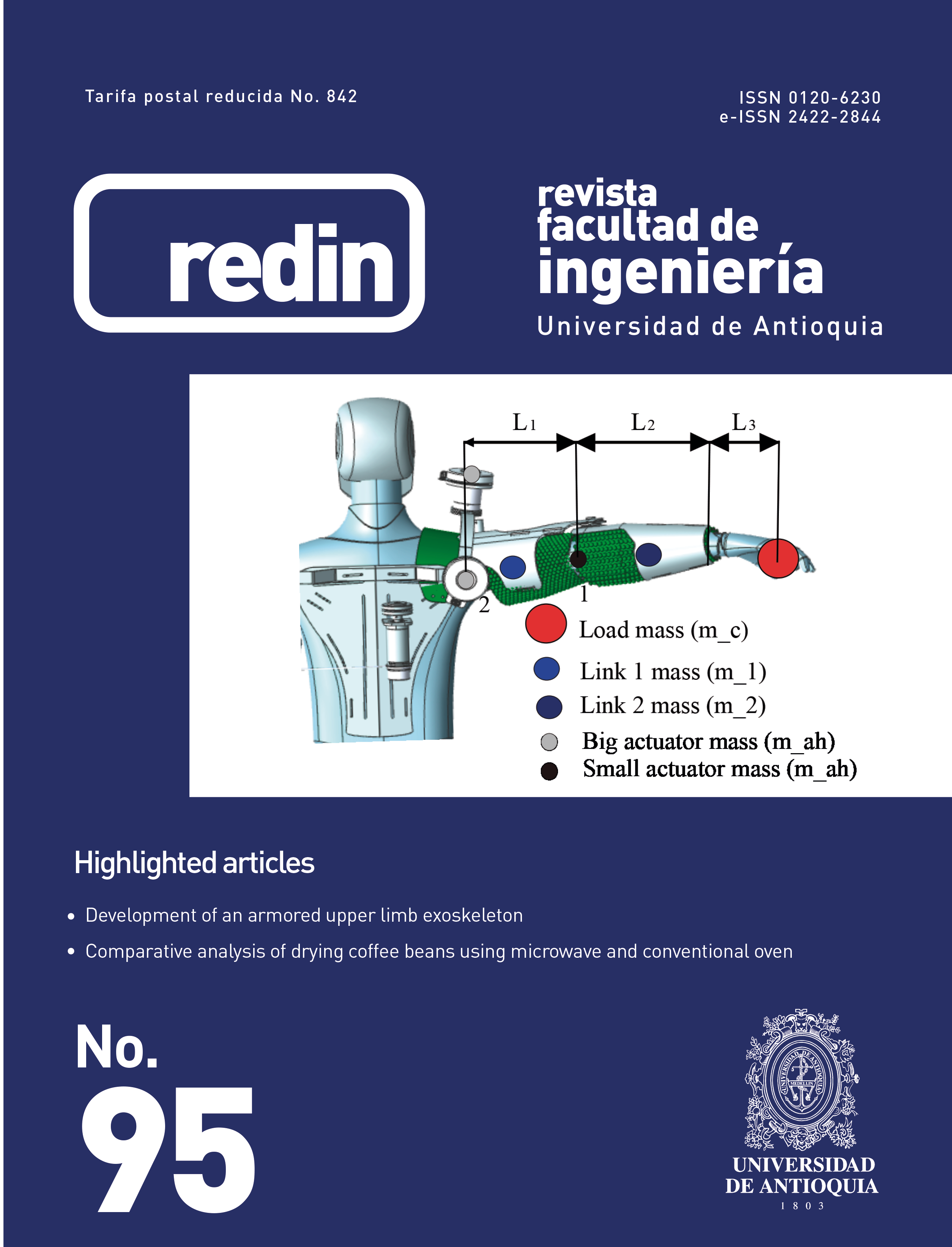Diseño de sistema de carga orientado a disminuir fuerzas de aceleración al portar un morral
DOI:
https://doi.org/10.17533/udea.redin.20190734Palabras clave:
biomecánica, morral, carga suspendidaResumen
En la vida militar, el transporte de cargas es una actividad inevitable durante operaciones de campo, razón por la cual los soldados hacen uso de un morral militar. Los soldados de infantería generalmente transportan cargas mayores al 30% de su peso corporal. Cuando el soldado transporta una carga, su gasto energético aumenta lo que ocasiona una reducción en su rendimiento. La carga transportada tiene un movimiento similar al desplazamiento vertical del centro de masa del soldado durante la marcha. Esto conlleva a un aumento significativo de las fuerzas de aceleración generadas por la acción de la carga sobre el cuerpo lo que explica el aumento del gasto energético. El objetivo del proyecto fue desarrollar un sistema de transporte de carga que la mantenga suspendida para así reducir su desplazamiento vertical. Los resultados muestran una reducción tanto en la excursión vertical como en la fuerza vertical total de reacción del suelo al transportar una carga con el prototipo desarrollado, respecto al morral militar convencional.
Descargas
Citas
J. J. Knapik, K. L. Reynolds, and E. Harman, “Soldier load carriage: Historical,physiological,biomechanical, and medical aspects,” Mil. Med., vol. 169, no. 1, January 2004. [Online]. Available: https://doi.org/10.7205/milmed.169.1.45
E. Harman, K. Hoon, P. Frykman, and C. Pandorf, “The effects of backpack weight on the biomechanics of load carriage,” Army Research Institute of Environmental Medicine Military Performance Division, Natick, U.S., Tech. Rep. ADA377886, May 2000.
S. A. Birrell, R. H. Hooper, and R. A. Haslam, “The effect of military load carriage on ground reaction forces,” Gait Posture, vol. 26, no. 4, October 2007. [Online]. Available: https://doi.org/10.1016/j.gaitpost.2006.12.008
J. F. Seay, “Biomechanics of load carriage,” in The Mechanobiology and Mechanophysiology of Military-Related Injuries, A. Gefen and Y. Epstein, Eds. New York, USA: Springer, 2016, pp. 71–106.
S. A. Gard, S. C. Miff, and A. D. Kuo, “Comparison of kinematic and kinetic methods for computing the vertical motion of the body center of mass during walking,” Hum. Mov. Sci., vol. 22, no. 6, April 2004. [Online]. Available: https://doi.org/10.1016/j.humov.2003.11.002
T. W. Huang and A. D. Kuo, “Mechanics and energetics of load carriage during human walking,” J. Exp. Biol., vol. 217, no. 4, February 2014. [Online]. Available: https://doi.org/10.1242/jeb.091587
L. C. Rome, L. Flynn, and T. D. Yoo, “Rubber bands reduce the cost of carrying loads,” Nature, vol. 444, pp. 1023–1024, 2006.
M. Foisssac, G. Y. Millet, A. Geyssant, P. Freychat, and A. Belli, “Characterization of the mechanical properties of backpacks and their influence on the energetics of walking,” J. Biomech., vol. 42, no. 2, January 2009. [Online]. Available: https://doi.org/10.1016/j. jbiomech.2008.10.012
J. B. Saunders, V. T. Inman, and H. D. Eberhart, “The major determinants in normal and pathological gait,” J Bone Joint Surg Am., vol. 35-A, no. 3, pp. 543–558, Jul. 1953.
J. Ackerman and J. Seipel, “A model of human walking with an elastically-suspended load,” J Biomech., vol. 47, no. 8, June 03 2014. [Online]. Available: https://doi.org/10.1016/j.jbiomech.2014.03.016
X. Xu, “An investigation on the interactivity between suspended-load backpack and human gait,” PhD dissertation, Department of Industrial and Systems Engineering, North Carolina State University, Raleigh, EE.UU, 2008.
N. K. Putra, Suprijanto, and A. B. Sriwarno, “Dynamic modeling and simulation of the suspended-load backpack to obtain optimal suspension parameters and reducing effect of ground reaction force,” in 6th World Congress of Biomechanics (WCB 2010), Singapore, Asia, 2010, pp. 111–114.
M. J. Atherden, “Formula sae shock absorber design,” M.S. thesis, School of Engineering, The University of Queesnland, St Lucia, Australia, 2004.
R. Ávila, L. R. Prado, and E. L. González, Dimensiones antropométricas de la población latinoamericana, 2nd ed. Guadalajara, México: Universidad de Guadalajara, Centro de investigaciones en ergonomia, 2007.
J. Park, “Design of the second spine: a secondary pathway to transfer loads from the shoulders to the pelvis,” in ASME 2013 International Design Engineering Technical Conferences and Computers and Information in Engineering Conference, Portland, Oregon, USA, 2013, pp. 4–7.
(2018) Materials information resource. Material Property Data. Accessed May. 2019. [Online]. Available: https://bit.ly/2WWRqbI
(2018) Proffessional 3D printing made accesible. materials. Ultimaker. Accessed May. 2019. [Online]. Available: https://bit.ly/2Y4o1cd
F. Multon and A. H. Olivier, “Biomechanics of walking in real world: Naturalness we wish to reach in virtual reality,” in Human Walking in Virtual Environments: Perception, Technology, Applications, F. Steinicke, Y. Visell, J. Campos, and A. Lécuyer, Eds. New York, USA: Springer, 2013, pp. 55–77.
Descargas
Publicado
Cómo citar
Número
Sección
Licencia
Derechos de autor 2020 Revista Facultad de Ingeniería Universidad de Antioquia

Esta obra está bajo una licencia internacional Creative Commons Atribución-NoComercial-CompartirIgual 4.0.
Los artículos disponibles en la Revista Facultad de Ingeniería, Universidad de Antioquia están bajo la licencia Creative Commons Attribution BY-NC-SA 4.0.
Eres libre de:
Compartir — copiar y redistribuir el material en cualquier medio o formato
Adaptar : remezclar, transformar y construir sobre el material.
Bajo los siguientes términos:
Reconocimiento : debe otorgar el crédito correspondiente , proporcionar un enlace a la licencia e indicar si se realizaron cambios . Puede hacerlo de cualquier manera razonable, pero no de ninguna manera que sugiera que el licenciante lo respalda a usted o su uso.
No comercial : no puede utilizar el material con fines comerciales .
Compartir igual : si remezcla, transforma o construye a partir del material, debe distribuir sus contribuciones bajo la misma licencia que el original.
El material publicado por la revista puede ser distribuido, copiado y exhibido por terceros si se dan los respectivos créditos a la revista, sin ningún costo. No se puede obtener ningún beneficio comercial y las obras derivadas tienen que estar bajo los mismos términos de licencia que el trabajo original.










 Twitter
Twitter